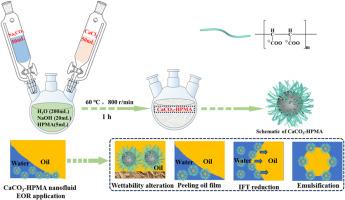Preparation of HPMA stabilized CaCO3 nanofluid and its EOR potential applied in low permeability reservoirs
IF 4.6
0 ENERGY & FUELS
引用次数: 0
Abstract
Nanofluid EOR applications face key challenges including poor stability and clogging in subsurface formations. This study developed a relatively stable CaCO3-HPMA nanofluid through hydrolyzed polymaleic anhydride (HPMA) modification method using a one-pot method. The CaCO3-HPMA nanofluid was characterized by FT-IR, TG, particle size analysis, SEM, zeta potential revealing spherical calcite and aragonite phase particles with an average diameter of 164 nm. CaCO3-HPMA (1000 mg/L) exhibited excellent stability, sustaining a zeta potential exceeding 30 mV after 10 d. The initial median particle size was 164.0 nm, which gradually increased to 201.2 nm after 10 d and reached 314.1 nm after 30 d CaCO3-HPMA (1000 mg/L) effectively altered the wettability of oil wet core slices to water wet, reducing the contact angle from 103.1° to 77.9°, lowered oil water interfacial tension to 14 mN/m, and achieved a 20 % emulsification index after 240 h at 60 °C. CaCO3-HPMA (1000 mg/L) nanofluid flooding and the secondary water flooding enhanced oil recovery 18.0 % compared to the primary water flooding in low permeability reservoirs. Notably, when formation clogging occurred, CaCO3-HPMA nanoparticles were effectively dissolved through acidification, providing a practical and versatile solution for field operations.

HPMA稳定CaCO3纳米流体的制备及其在低渗透油藏中的提高采收率潜力
纳米流体EOR应用面临着稳定性差和地下地层堵塞等关键挑战。本研究采用一锅法,通过水解聚马来酸酐(HPMA)改性的方法,制备了相对稳定的CaCO3-HPMA纳米流体。采用FT-IR、TG、粒度分析、SEM、zeta电位等手段对CaCO3-HPMA纳米流体进行表征,发现平均直径为164 nm的球形方解石和文石相颗粒。CaCO3-HPMA (1000 mg / L)表现出出色的稳定性,保持电动电势超过30 mV后10 d。最初的平均粒径为164.0 nm,逐渐增加到201.2 nm, 30 d后10 d和达到314.1 nm CaCO3-HPMA (1000 mg / L)有效地改变了油湿岩心的润湿性片水湿,减少接触角从103.1°到77.9°,降低油水界面张力至14 mN / m, 240 h后,取得了20%的乳化指数60°C。在低渗透油藏中,CaCO3-HPMA (1000 mg/L)纳米流体驱油与二次水驱相比,采收率提高18.0%。值得注意的是,当地层堵塞发生时,CaCO3-HPMA纳米颗粒通过酸化有效溶解,为现场作业提供了实用且通用的解决方案。
本文章由计算机程序翻译,如有差异,请以英文原文为准。
求助全文
约1分钟内获得全文
求助全文

 求助内容:
求助内容: 应助结果提醒方式:
应助结果提醒方式:


